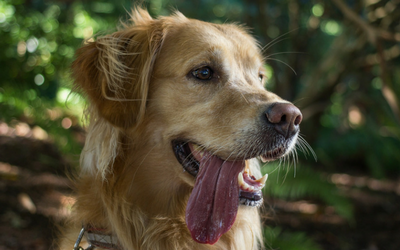
Summer temperatures are soaring! Even a short walk in the blazing sun is enough to make us hot and in need of a cool drink. Imagine how your dog feels if he has to stay outdoors for extended periods of time in the heat.
Overheating goes by many names: heat exhaustion, heat stroke, or heat prostration. It doesn’t matter what you call it – overheating equals trouble for dogs. Extreme heat can cause more than just discomfort, it can make pets quite ill, and elevated body temperatures can be fatal.
What causes heat exhaustion?
Heat exhaustion is more likely to occur when both temperature and humidity are high. Increased humidity makes it difficult for the body to cool itself. As the humidity increases, the environment feels warmer than it actually is.
When a dog experiences heat exhaustion, his body temperature may rise rapidly from about 101.5⁰F (38⁰C) to 104-105⁰F (40-40.6⁰C). When the dog’s body reaches these temperatures, the dog is unable to regulate his body temperature, which continues to rise. At these temperatures, internal organs can be damaged and without a quick cool down, major organs may become irreversibly damaged.
One of the most common causes of death due to heat exhaustion is dogs being left in a car in hot weather with the windows closed. Never leave your dog in the car, not even to run a “quick errand”.
Are dogs more prone to heat exhaustion than people?
Dogs are more prone to heat exhaustion because they don’t regulate their body temperature the same way people do. When we become overheated, we perspire. The perspiration evaporates helping to cool the body.
Dogs on the other hand do not perspire. Dogs lose excess body heat by panting which doesn’t work as well as sweating. Plus, they have a fur coat on which they can’t take off! They can’t turn on a fan to sit in front of, or pour a tall cold glass of water.
Are certain dogs predisposed to heat exhaustion?
Any dog can experience heat exhaustion, but some are more prone than others. The very young or very old tend to have more difficulties with overheating, as do overweight dogs. Breeds with short noses such as Boston Terriers, Pugs, Bulldogs, and Shih Tzus don’t dissipate heat as well as long-nosed breeds. Dogs with heavy, thick coats, such as Huskies or St Bernards, can overheat much more quickly than other dogs. These breeds need extra care and caution during hot and humid weather.
Preventing heat exhaustion in dogs
It is our responsibility to provide protection from the summer heat for our dogs, especially those that spend a lot of time outdoors, or may be more prone to heat exhaustion.
Make sure there is plenty of shade in the yard and train your dog to rest there by placing his water bowl and toys under a shade tree, canopy, or covered patio. Provide a constant supply of fresh water and keep it cool by adding ice cubes to the bowl.
Some dogs find a quick dip in the water very refreshing. A plastic kiddie pool works well. If you have a swimming pool, train your dog to swim and to use the steps to exit the pool. Dogs cannot climb ladders, and accidental drownings occur every summer as dogs exhaust themselves when they can’t find a way out of the pool. If your pool only has a ladder, do not allow your dog to go in the pool unless you can lift him out and you are supervising the swim.
Don’t exercise your dog during the hottest part of the day. Take him for walks early in the morning or late in the evening when the temperature is cooler. Take shorter walks than usual. Bring a dog water bottle or collapsible water dish with lots of water and stop frequently for drink breaks. Avoid the sunny side of the street and find a shaded area to exercise. Give your dog a spray down with the hose when you get home, but let the water flow for a few minutes before spraying your dog as water left sitting in the hose will be hot to enough to burn your dog.
What are the signs of heat exhaustion?
It’s important for you to recognize the warning signs of heat exhaustion. Pets that suffer heat exhaustion may show the following signs:
- Excessive panting
- Pale gums
- Increased heart rate
- Drooling thick, ropey saliva
- Vomiting
With extreme heat exhaustion, dogs experience breathing difficulties and may become disoriented or non-responsive. They may collapse and be unable to move. In the most difficult cases, dogs become comatose and die.
At-home treatment for heat exhaustion
If you notice any of these signs in your dog, provide emergency care and get to your veterinarian as quickly as possible. Immediately move your dog to a cooler area inside an air-conditioned house, under a shade tree, or in front of a fan. Wet him with cool (NOT ice cold) water. Gently wet him with a hose or immerse him in a tub of cool water. Do not force him to drink water. Place wet towels on him and drive to your veterinary clinic with the air conditioner running in your car.
Veterinary care
Your veterinarian will begin other life-saving measures in the hospital to avoid organ damage. This may include an IV with rehydrating fluids, medications to stabilize respiration and shock, and may include a hospital stay for further treatment and laboratory tests to assess organ function.
Summer is great time to be outdoors! Enjoy the summer weather and take care to prevent heat exhaustion in your dog (and yourself).